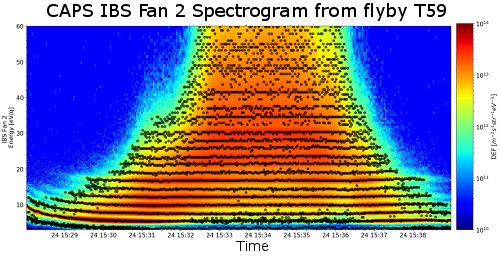Heavy positive ion groups in Titan's ionosphere: Cassini Plasma Spectrometer IBS observations
- 1Mullard Space Science Laboratory, UCL, Dorking, UK
- 2Centre for Planetary Sciences, UCL/Birkbeck, London, UK
- 3Space Science Division, Southwest Research Institute, San Antonio, USA
Abstract
Data from the Cassini Plasma Spectrometer Ion Beam Spectrometer (CAPS IBS) sensor have been examined for 5 close encounters of Titan during 2009 to examine heavy positive ions. Positive ions with masses between 170 and 310 u/q are examined. Ion mass groups are identified up to 275 u/q with ion groups below 250 u/q having clear structure with a 12-14 u/q spacing between group peaks.
The ion group peaks are found to be consistent with masses of polycyclic aromatic hydrocarbon (PAH) and polycyclic aromatic nitrogen heterocyclics (PANH). The ion groups in this study are the heaviest positive ion groups examined so far from in-situ ion data at Titan. Our findings further the understanding of the link between low mass ions and high mass negative ions, as well as the formation of aerosols in Titan's atmosphere.
Introduction
Titan is the largest moon of Saturn and has a thick extended atmosphere along with a large ionosphere. The ionosphere has been shown to contain a plethora of hydrocarbon/nitrile cations and anions1.
Previous ion composition studies in Titan’s ionosphere by Cassini instruments revealed "families" of ions around particular mass values and a regular spacing of 12 to 14 u/q between mass groups2. These are thought to be related to a carbon or nitrogen backbone that dominates the ion chemistry2. Previous studies also identified possible heavy ions such as naphthalene, anthracene derivatives and an anthracene dimer at 130, 170 and 335 u/q respectively1. Later flybys demonstrated the existence of even larger positive ions up to masses of 1100 u/q3.
Methodology
The Cassini Plasma Spectrometer Ion Beam Spectrometer (CAPS IBS)4 is an electrostatic analyser that measures energy per charge ratios of ions. During the Titan flybys Cassini had a high velocity (~6 km/s) relative to the low ion velocities (<230 m/s) observed in the ionosphere. The ions were also cold, having ion temperatures around 150K. The combination of these factors meant that the ions appeared as a highly-directed supersonic beam in the spacecraft frame. This means the ions appear at kinetic energies associated with the spacecraft velocity and the ion mass, therefore the measured eV/q spectra can be converted to u/q spectra.

Figure 1 – A time-energy spectrogram showing the data obtained using CAPS IBS during the T59 flyby on 24th July 2009. Time is displayed on the x-axis, energy on the y-axis and intensity shown in the colour. Overlaid with dots are identified peaks in the energy spectra.
Results and Conclusions
Positive ions with masses between 170 and 300 u/q have been examined during five flybys of Titan performed by Cassini during 2009. Ion groups up to 275 u/q are found, representing molecular ions with up to 21 heavy (carbon/nitrogen/oxygen) atoms. Up to 250 u/q a regular spacing of 12 to 14 u/q between the most abundant ions is found, indicating a carbon or nitrogen backbone. Between 275 and 310 u/q, several prominent peaks are found but with no associated group structure. Peaks identified up to 275 u/q have masses consistent with cations deriving from multiple fused ring structures such as PAHs and PANHs and contain 3, 4 or 5 fused rings. Some of the peaks observed between 275 and 310 u/q are consistent with 5 and 6 ringed structures.
Previous work has identified a strong emission at 3.3µm that can be fitted using spectra from several neutral PAHs and PANHs5. The fitted neutrals are compared with the ion peaks and the peaks are found to appear at similar masses to the fitted neutrals. This implies there is coupling between the ion and neutral phases at these masses.
These are the largest distinct positive ion groups reported so far in Titan's ionosphere. The discovery of these groups will aid future atmospheric chemical models of Titan through identification of prominent heavy positive ions, aiding understanding of which reaction pathways are plausible to create the previously found heavy negative ions, neutrals and aerosols.
References
How to cite: Haythornthwaite, R., Coates, A., Jones, G., Wellbrock, A., and Waite, H.: Heavy positive ion groups in Titan's ionosphere: Cassini Plasma Spectrometer IBS observations, Europlanet Science Congress 2020, online, 21 September–9 Oct 2020, EPSC2020-671, https://doi.org/10.5194/epsc2020-671, 2020

